Dare I say it? From what I am noticing internationally, we are in the midst of a new wave of appreciation for older dancers. At the moment several superstars of dance are crashing the age barrier. But I think it goes beyond those extraordinary artists to dancers who are less well known. This post includes examples of both types, quotes from observers and practitioners, and Pat Catterson’s (somewhat humorous) list of roadblocks for those dancers trying to beat the odds.
First the Superstars
Alessandra Ferri, Wendy Whelan, and Carmen de Lavallade are each totally unique dancers, a world unto themselves, and that is part of the reason their artistry has endured.
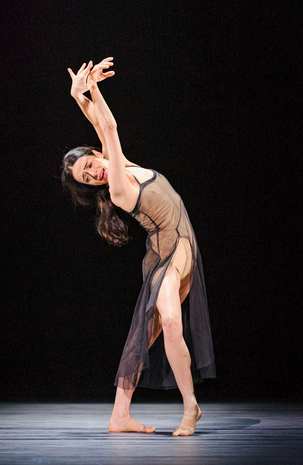
Ferri in McGregor’s Woolf Works © ROH, photo by Tristram Kenton
As seen in Martha Clarke’s Cheri, the exquisitely dramatic Ferri, 52, can still transport us from rapturous joy to utter despair. (See Gia Kourlas’ cover story for Dance Magazine from last fall.) And just last month, she performed at Covent Garden as the muse for Wayne McGregor in Woolf Works at The Royal Ballet. For me, as I posted in “Alessandra’s Ferri’s Knowing Body,” the ballet completely relied on Ferri’s ability to create a passionate yet vulnerable protagonist.
At the Joyce in April, Wendy Whelan, 48, danced with all the fullness and thrust she always had in “Restless Creature.” And last weekend, in a Works & Process program at the Guggenheim, she showed a sassy theatricality in Arthur Pita’s Tango that I hadn’t seen before. (In case you aren’t familiar with her glorious dancing, what I wrote about her in my recent tribute to her at Danspace still holds true.)
Brian Schaefer, posting in OUT.com, wrote that Whelan’s age “allowed for greater possibilities in interpreting the relationships and interactions on stage. It also added something soothing and serene to each work—maybe we can call it wisdom.” He went on to say, “Especially in ballet, young love still reigns. But with Restless Creature, Whelan…steps beyond ballet’s suggested expiration date and demonstrates that lifelong curiosity and experience are as valuable artistic tools as pirouettes and penchée.”
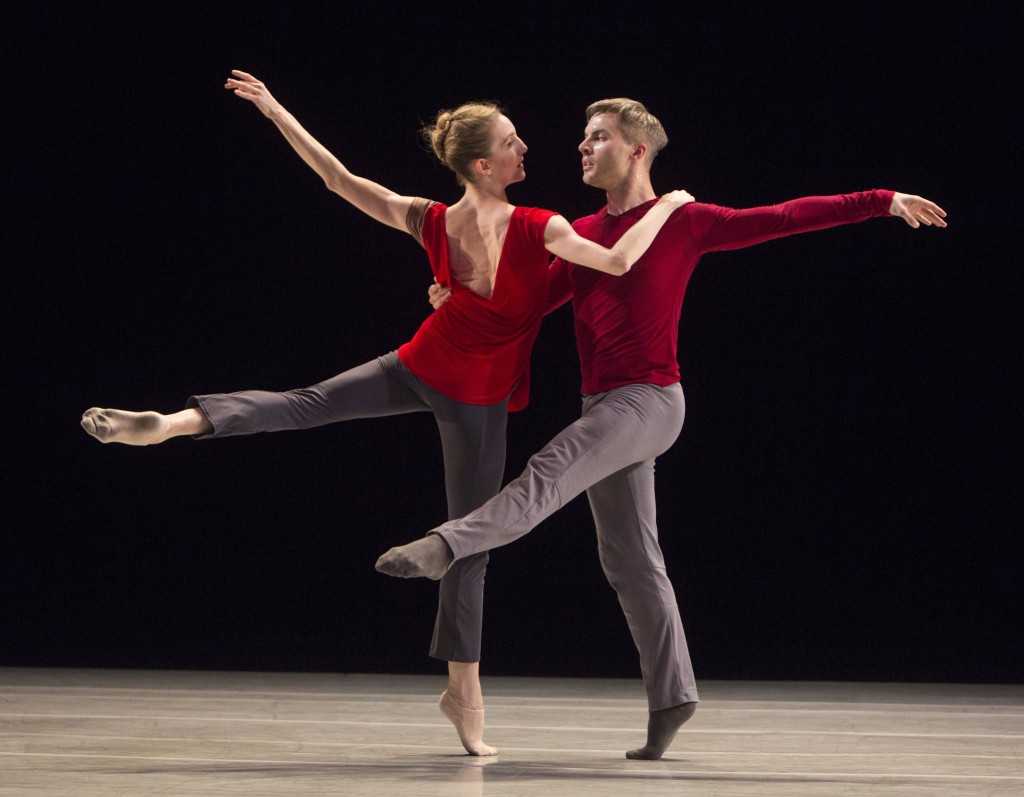
Wendy Whelan with Joshua Beamish in Restless Creature, photo © Yi-Chun Wu
The legendary Carmen de Lavallade, at 83, knocked ’em dead at Jacob’s Pillow last year in her show As I Remember It. She also became an object of desire at Huffington Post. Brian Seibert of The New York Times called her dancing terrific. And Erin Bomboy of the Dance Enthusiast described her as “mesmerizing and silky.” NPR also jumped into the Let’s-discover-Carmen act with this segment on her.
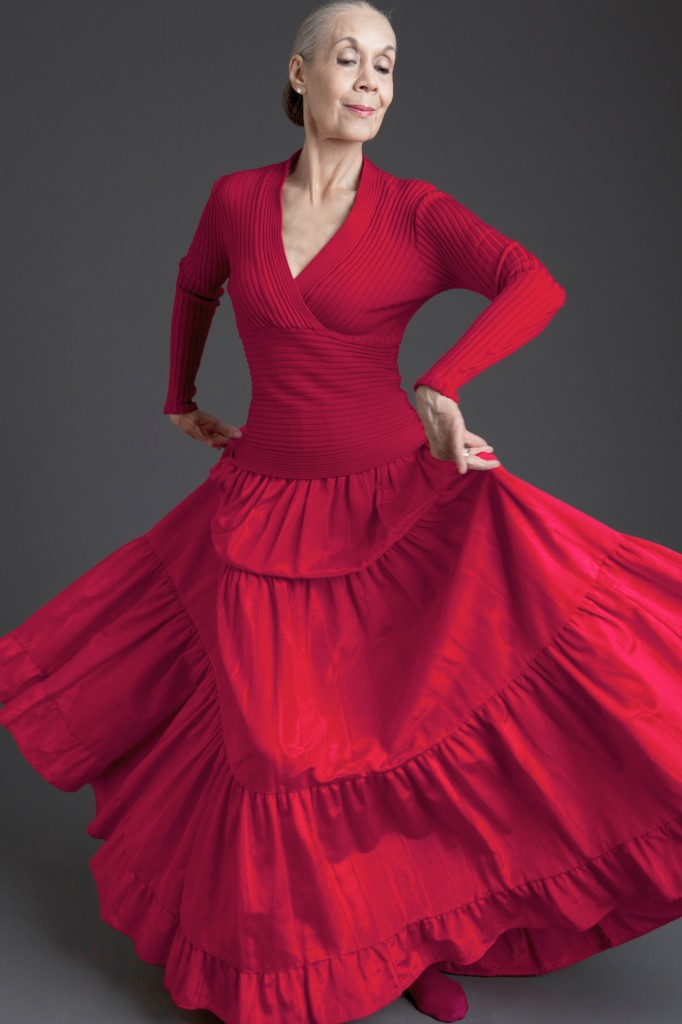
Carmen de Lavallade, photo: © 2011 Julieta Cervantes
Ageless in Europe
As it happens, venerable superstars of Europe are performing in Rome on June 24 and 25. In a presentation of Daniele Cipriani Entertainment http://www.dancemagazine.com/blogs/admin-admin/6468 the Swedish choreographer Mats Ek and his illustrious wife, Spanish-born Ana Laguna, will perform two of the most sparely poetic works I’ve ever seen: Memory and Potato. He is 70 and she is 60. The program, entitled “Quartet Gala,” also includes well known Tanztheater choreographer Susanne Linke, who turns 71 this month, and Bessie-award-winning Pina Bausch dancer, French-born Dominique Mercy, 65. For more info on the program, which has choreography by Ek, Linke, and Pascal Merighi, click here.
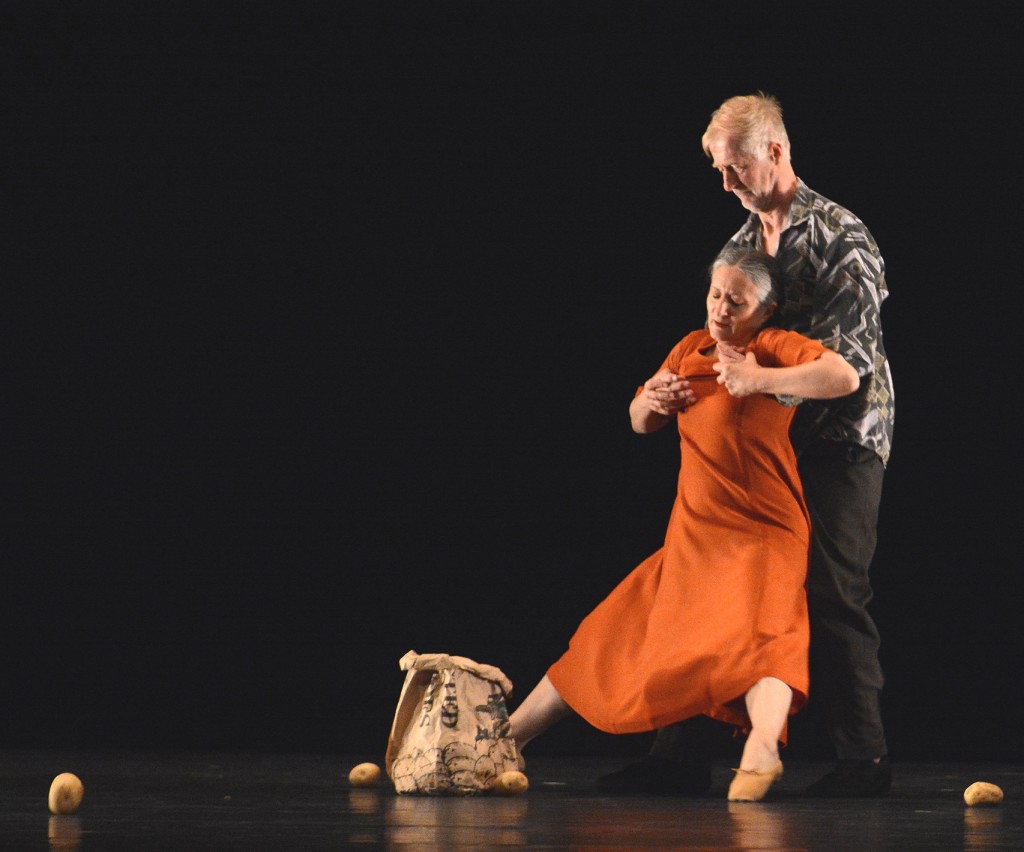
Ana Laguna and Mats Ek in Ek’s Potato, photo © John Ross
Postmodern Forever
Simone Forti at 80 still performs. Though she’s not quite as stable as before, her earthiness and wit are still accessible to her. In an online Fjord Review about Forti’s recent shared performance in Los Angeles, Victoria Looseleaf described her as “Monumental in her simplicity.”
Another historic figure who helped redefine dance in the 1960s, Yvonne Rainer, also 80, brought her premiere Dust to the Museum of Modern Art this month. Rainer supposedly doesn’t dance any longer—though she slipped in a quick chassé and a hovering relevé during the June 13th performance. In an advance story in The New York Times, Siobhan Burke quoted Rainer saying, “My preferred mode of self-presentation is ‘existence.’ I love to exist on stage. I no longer ‘dance.’ ” Later in the article Rainer claimed a right for the aging dancer to exist without judgment: “The aging body is a thing unto itself and need not be judged as inadequate or inferior if it can no longer jump through hoops.”
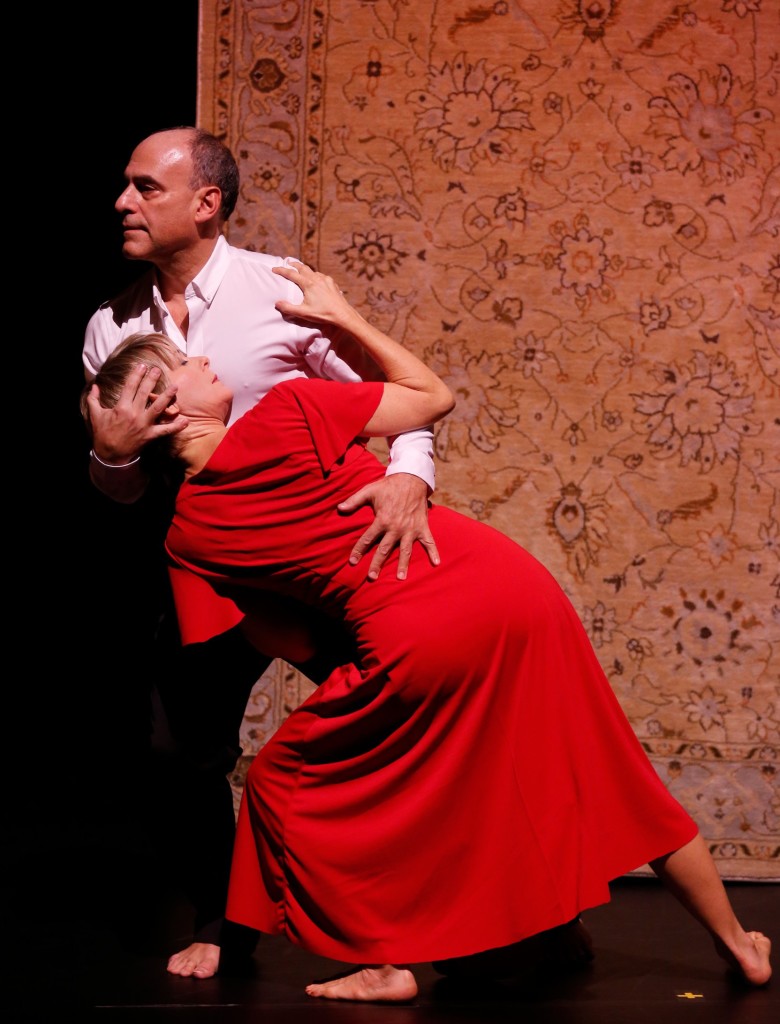
Stephan Koplowitz and Heather Ehlers in Connor’s The Weather in the Room, photo © Scott Groller
Choreographer Colin Connor cast two dancers over 50 for his work The Weather in a Room that premiered at CalArts last year. They were faculty members Stephan Koplowitz (dean of the School of Dance) and Heather Ehlers (of the School of Theater). He believes in age diversity onstage. Partly because, like Schaefer, he is interested in the relationships that older dancers can inhabit. “In our time,” he wrote in an email to me, “dance tends toward youth, to newness, and to the illustration of things youthful. Here I was drawn to the idea of a relationship that is not new but lived in, to a landscape of ongoing experience and the expressiveness of maturity, and to revealing a palpable physical intimacy between people of an age where this is less noticed or considered.”
Another choreographer interested in age diversity is Vicky Shick, who at 62 still dances in her own work. I happen to be on the receiving end of her largesse and have performed in two of her recent pieces. We’ve danced in each other’s work before so she knows my body and won’t overextend. In rehearsals, I loll around, slowly warming up my body, while she works with the other dancers until it’s my turn.
And just last week I participated in American Dance Guild’s tribute to Frances Alenikoff, who danced into her 80s. I am 67, and my dancing partners were Deborah Jowitt, 81, and Ze’eva Cohen, 75. On performance days, I would go through my daily exercises more thoroughly and add extra time for balancing on one leg. I widened the stance of some of the moves in an effort to be more stable. In performance, I sometimes had the thought, Whew, I got through that bit without keeling over!
Nothing New
Of course the interest in older performers is nothing new. Liz Lerman started using older people in her dances in the 1970s; the Dance Exchange in Takoma Park, MD, carries on her tradition in some of its programs. Choreographers like Stephan Koplowitz and Risa Jaroslow have chosen to work with older performers. Naomi Goldberg’s currently active Dances for Variable Population gives performances and workshops throughout the summer. These kinds of explorations ask the question, Who gets to dance?
Almost twenty years ago Gus Solomons, along with Carmen de Lavallade and the late Dudley Williams, started Paradigm Dance Company, which challenged choreographers like Dwight Rhoden and Kate Weare to make work for these storied but limited performers. Valda Setterfield, 80, whose stage charisma grows with each decade, has danced with Paradigm as well as with her husband David Gordon.
Between This World and the Next
When I wrote about older dancers for The New York Times 15 years ago, I quoted Eiko Otake saying, “Because their bodies are not young, older performers carry something that is almost between this world and the next, that itself is artistic and transcending.’”
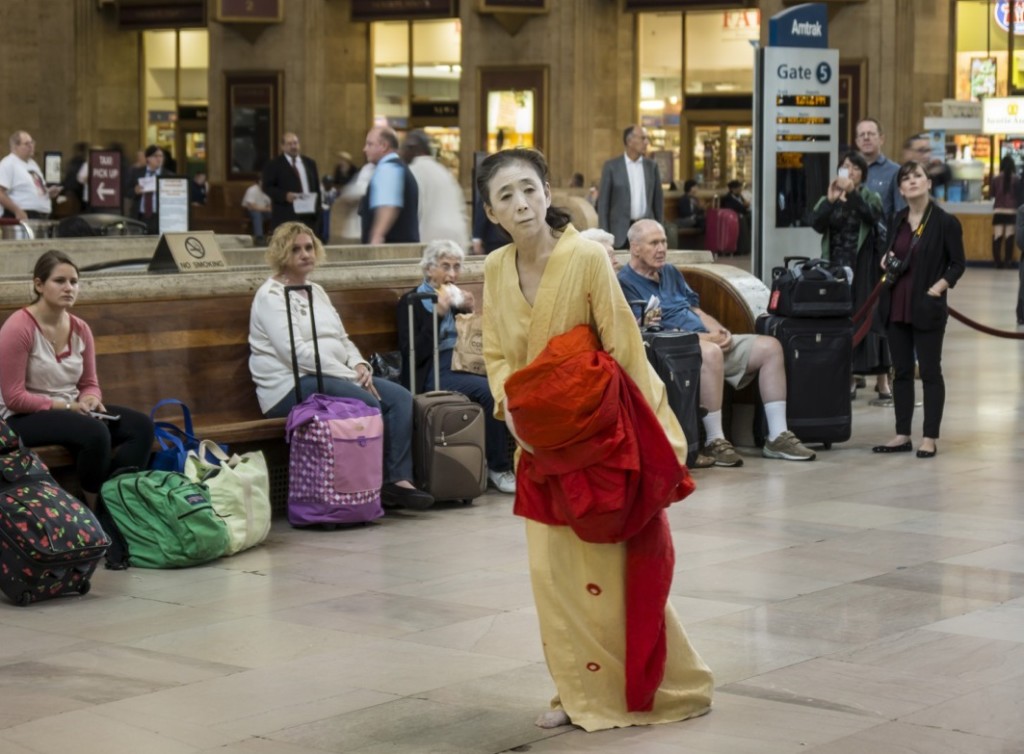
Eiko in A Body in a Station, photo © William Johnston
Now in her early 60s, Eiko has been illustrating that idea with her haunting current project, A Body in a Station.
About a year ago, I was fortunate to see butoh artist Ko Murobushi in Yokohama, who embodied a certain brute strength as a man in his late 50s. But this work too, with it’s sudden falls and its offering of lilies, hinted at death.
Alternative Vision
To return to Rainer, she sees the acceptance of age as an “alternative vision.” Here’s an excerpt from an essay she wrote last year for Performance Art Journal (PAJ 106):
“The evolution of the aging body in dance fulfills the earliest aspirations of my 1960s peers and colleagues who tore down the palace gates of high culture to admit a rabble of alternative visions and options. Silence, noise, walking, running, detritus—all undermined prevailing standards of monumentality, beauty, grace, professionalism, and the heroic.”
PatCat’s Nine Lives, or, How to Dance Full Out at 69
But maybe older dancers are a new kind of heroic. Enter Pat Catterson, a dancer/choreographer/teacher who dances full out as a member of Rainer’s group—at 69 years old. (The other members are not far behind: they are all over 40.) She never stopped taking daily class. I asked her to tell me the hardest thing about keeping her body in dancing shape, and she came up with nine hardest things. The rest of this post is direct from Pat Catterson’s lips—or rather email.
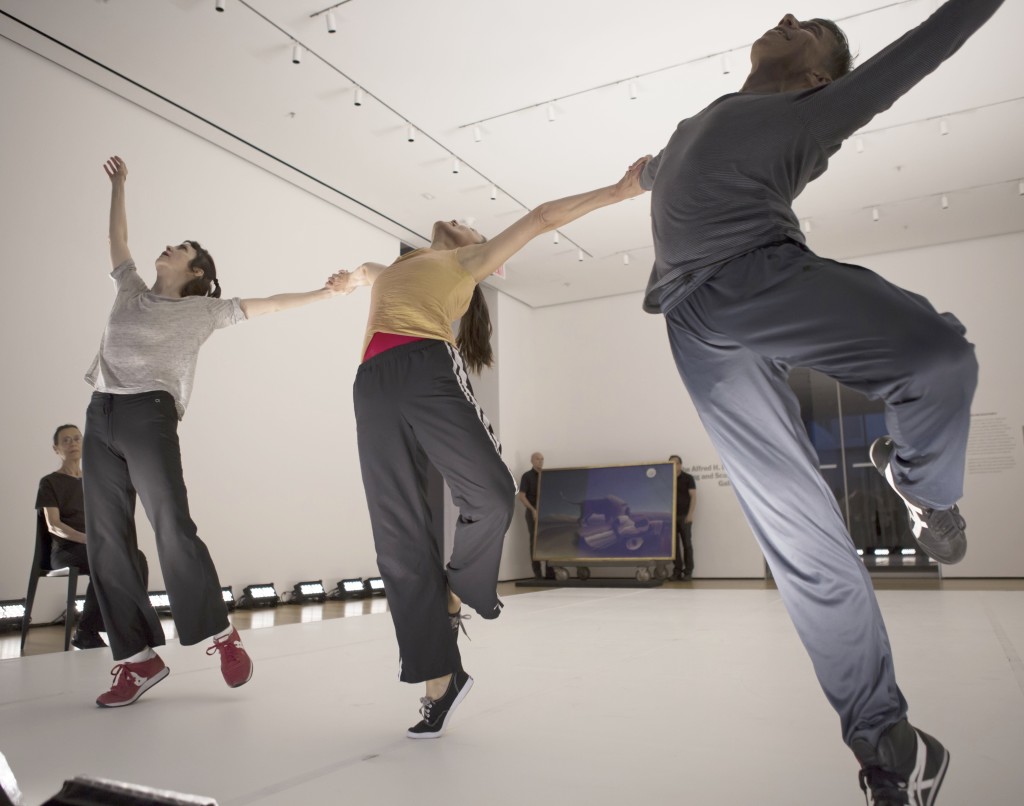
From left: Yvonne Rainer, Pat Catterson, Patricia Hoffbauer, and Keith Sabado in Dust at MoMA. Rousseau’s painting of The Sleeping Gypsy is in background, photo © Julieta Cervantes
1. It is difficult to walk the fine line between challenging my body and not overdoing. I can so easily inflame something if I do too much repetition or work past muscle fatigue or not give myself enough recuperation time. When to push and when not is hard to gauge. And the balance is always changing. What I could do two years ago in terms of endurance, I cannot do now.
2. Doctors are dismissive. Oh it is arthritis they say and treat me like I am some kind of crazy person who thinks she can still dance. I try to convince them that I take full class six days a week and am performing and intend to continue but most of them do not take me seriously. It infuriates me. But then I wonder if I am a fool. I find physical therapists more encouraging and helpful than doctors.
3. My brain does not work as quickly as it used to. One of my strengths was always that I picked up quickly. I got the steps fast and often led across the floor. It may not be noticeable to others but I do not pick up as fast now and I have to work at it. Sometimes just as we are to begin a combination, my mind goes blank and I cannot even remember how it starts. The brain does age.
4. I am ignored when I take class. I am used to it now. I am very self-disciplined but I could use a correction now and then, an outside eye. (An exception: Rachel List always gives me corrections.) It is really strange to feel so invisible. And it makes me a little angry, frankly. I am paying for the class like everyone else!
5. I need to rent some ballon! I still could do convincing jumps one year ago but then it ended. I am in shape and I jump every day but I do not go up! I am strong. I stretch. I practice jumping. But the ballon disappeared! I still love leaps and jumping steps anyway even though I look quite unimpressive doing them.
6. My joints are stiff, particularly in my hips. It is very hard to get up and down from the floor. I can only do it in certain pathways. I try to cover it up as best I can by the choices I make. The body just does not fold easily in the joints anymore. Grand plié is now not so grand. Annoying. I am so envious of the ease of the others as I struggle to do things that used to be so easy.
7. Dance clothes. Clingy does not look good on saggy skin! I am bony and I have muscle tone but the skin is saggy. I cannot wear the biketards or the skin-baring tops or leotards the others wear in the summer. I want to wear something sleek and contemporary looking but most regular dancewear just looks ridiculous on me. My age group is not the focus of dancewear companies.
8. In class, I used to love just barreling into everything but that is not possible now. I usually start a big or fast combination a little under in energy to pattern it first in my body so that I don’t strain myself. I can build up to a good energy but I have to start soft. I look at the young ’uns and I remember well that agility and energy. But I do take the full class. Use it or lose it as they say. I try to push past what feels completely comfortable, but just how much is a continual negotiation. Friends who are in their 40s or 50s think I am crazy to continue to take full class, especially Cunningham technique. One says that Cunningham is for young bodies and that I shouldn’t be putting my body through it. But it is my “home” technique and I love the physical and mental challenge of it.
9. In the end I love to dance and perform as much as I always did. The adrenaline of performing still carries me beyond what I think I can do. I have a lot of energy, but I do not want to end up crippled or in a wheelchair. I have to be able to know when to stop demanding too much of my body. And only I will know because the doctors do not know.
Featured Uncategorized 18
Hello Wendy, you very kindly emailed me about a year ago regarding my research “Ageism and the mature dancer” which has transformed into a PhD! Your article: Aging Dancers; has been most informative on the US side of things. I am a British mature dancer based in Qld Australia. The research has me returning home often (London) and further afield, Sweden in October. I am currently working with British mature dancers, former RBC and Les Grands Ballets Canadiens and the Australian Dance Artists, featuring Patrick Harding Irmer and Anca Frankenhaeuser, both former LCDT! http://www.australiandanceartists.com
Most to the dancers in the research are over 50 and I have one lady aged 100, Eileen Kramer, who is extraordinary. I attended the Elixir Festival at Sadler’s Wells last year and witnessed the wonderful performances of Mats Ek, Ana Laguna and Dominique Mercy; the latter brought the house down! Europe is brimful of mature exemplars: Charlotta Ofverholm of Compagnie Jus de la Vie for example. Her company is hosting a festival in October celebrating AGE ON STAGE: http://new.jusdelavie.org/?p=1477
If you are able to direct me to Pat Catterson or Alessandra Ferri or forward my email address they would be fantastic editions to the research, which currently holds over 25 dancers from the UK, Australia, Sweden, Holland and Canada. They have all answered a questionnaire regarding their process and physicality as mature dancers: in essence giving the mature dancer ‘a voice, validation and visibility’
Your article was brim full of information – thank you so much!
I am a dancer over 60 and my mother dances ballroom at 90, it is a fountain #of youth. I take Jazz, Hip Hop and Musical Theatre classes. Living near a college is a WOW factor. DANCE is taught in a Sterling Environment that looks at you with curiosity and respect. DANCE is a fountain of youth!
Hi Sonia I am a dance educator in Perth. I would love to hear more about your research, do you have anything in print?
Thank you
Angela
Sonia, please see response from Angela Perry.
Wendy, thank you for this wonderful article. Yes, I am still dancing as well. I feel the difference and changes as I age but I am so grateful to still be in class with all the lovely young dancers.
Where to begin. Age 8. Ballet. Now age 86, ballet class, every day that I can work it in, along with the mammoth desk work and prep and arrangements and bookings involved in directing Young Dancemakers Company (about to open 20th season, this Monday, and just as nervous about delivering my teaching material as I was the first day I ever taught). The ringer, in class, is the balance. But barre is great. Love it, and it loves me. Yes, I am performing still and getting positive response. I know my limitations and I can live on stage with them. Next up is a duet with Marsi Burns in September for David’s WET series. And had a revelation this month, as guest artist for Naomi’s Dances for a Variable Population. Performed a duet, with a younger dancer. Loved it. AND choreographed a work for 4 seniors. They were superb, gave it their all, enjoyed the whole process, and audience cheered. And these seniors are younger than me.
If your calling is to dance – you dance – for as long as the vessel says yes… At 56 … Just premiered an evening length work in Ljubjlana with dancers 26, 28, 36. I love the liberation and wisdom that comes with age, and the discovery of new modalities that enable bodies adjusting to time. the soul is infinite and eternal. with age, the facade of athleticism and technique sheds, the majesty of the human spirit and triumph of the soul’s journey seems much clearer. grateful !
Aging Dancers- An Alternate Vision…beautifully illuminated in your article. There are 2 activities in Toronto- my series, Older & Reckless, for older dancers and intergenerational dance initiatives, and Cloud 9, for aging dancers in ensemble projects currently housed by my company MOonhORsE. How wonderful to get insights from other corners of the world. Thanks for opening the curtain, Wendy…from a fellow dance addict, still performing at 62.
Hi Wendy,
would you be interested in meeting with the Diamond group at CTFD?
Please explain what the Diamond group at CTFD is.
As I approach 70 years and am going through physical rehabilitation due to a car accident (and age) that I wish to note that I am given such heart and energy from Ms Rainer’s descriptive writing that I just want to offer thanks to her from someone who is traversing life’s journey with concurrent pace…so thank you Ms Rainer.
In 2000 I began an annual series I called THE GLUE FACTORY PROJECT – full evening dance theater works I created on “nationally and internationally renowned performers over the age of 45”. It ran in Minneapolis, MN for four years. Sold out performances. In 2010 I returned to producing this, but now do create two full-evening length original works a year. Most of the artists I engage are 50++++, and have included many well known performing artists. Having spent a great deal of my career in Europe, this concept of older dancers was nothing new to me. After years of running a company where I got older and the dancers seemed to get younger, I realized I was making work more for them and not for me. Hence the conception of the GLUE FACTORY PROJECT. The work is more nuanced, more layered, more reflective of being an adult. The performers are far more nuanced, more layered, more adult. It’s exciting as an artist to create at this level. It’s wonderful to share this with audiences – of all ages – but many come and see themselves reflected not only in the bodies on stage, but in the themes explored in the work. 60+ this is exciting.
This is a blog on the Dancing Over 50 Project by Santa Fe writer Emmaly Wiederholt that I came across when she wrote about Mark Haim. She focuses geographically on the west coast. Some other names I recognized are Shirley Jenkins and Anna Halprin. http://stanceondance.com/dancing-over-50/
You should know about The Elders Ensemble, a second company of Prometheus Dance, co-artistic directors Diane Arvanites and Tommy Neblett. Go to the prometheusdance.org website and click on Elders Ensemble. We are a group of 8 elder women dancers, ages 64 to 92.
We have an annual spring concert in Cambridge, MA and an outreach program to local senior centers in surrounding communities and assisted living residences.
Wendy, thanks for this great article. Well, the whole population is aging, and maybe that is finally dislodging some of the fixed ideas in dance, too. Having started at 3, I’m still teaching, choreographing and performing in my 60’s now. I have to thank my mentor Erick Hawkins whose technical principles have proven very wise and life-extending for me and those I teach. We have to appreciate also the breakthroughs made by Erick and the other Modern Dance artists who insisted that dance could be an art form for grown up people and grown up ideas, not just the “look ma I’m dancin'” crew. An idea whose time has come perhaps?
Wonderful article and comments!
I am 76 dancing and teaching on Genève (switzerland)
Loving Italie!
Dany
Hello Wendy, Toby Towson here, 70 years young and still dancing too, so I read your article with interest. My latest dance, “Smile” choreographed to Nat King Cole singing that song, has a held handstand and headstand, and four cartwheels as well as all the dance steps. I only perform occasionally but get lovely and enthusiastic feedback when I do. I hope to post it on you tube soon so I can share that way. Hope this finds you well. My family and I are going to watch Wendy Whelan at U of MD in December. Best wishes, Toby
I am the director of HBY Ensemble, a professional dance company for artists over 40 in the Detroit, MI area. Thank you for this article! I am 57 and continue to perform as well as teach and so do my company members at Holistic Ballet Yoga.